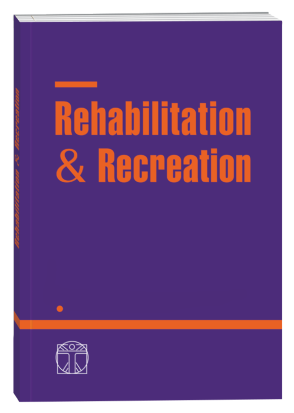COMPARISON OF THE EFFECTIVENESS OF EXERCISES ON THE “RESPINE” DEVICE WITH AND WITHOUT BREATHING EXERCISES IN PEOPLE WITH CHRONIC LOWER BACK PAIN
DOI:
https://doi.org/10.32782/2522-1795.2025.19.2.4Keywords:
back pain, Respine, breathing exercises, chronic pain, rehabilitation exercises, movement therapy, rehabilitation effectivenessAbstract
This study aimed to compare the effectiveness of exercises performed on «Respine» device with and without the additional breathing exercises in patients with chronic low back pain (LBP). Chronic low back pain affects 23% of adults worldwide, with a recurrence rate of 24–80% per year, posing a significant healthcare challenge. The study involved 44 subjects with chronic nonspecific lower back pain, randomly assigned to two groups: a control group (n=22) receiving a standard exercise program on «Respine» device, and a study group (n=22) following the same program with additing specialized breathing exercises. The intervention lasted 6 weeks with a frequency of 4 sessions per week. Assessments were made using Numeric Rating Scale (NRS), Revised Oswestry Low Back Pain Disability Scale questionnaire, measurement of the number of breaths per minute, analysis of breathing track and lower rib mobility. At the end of the study, a significant reduction in pain was observed in both groups with no significant difference between them (control group: from 4.47 to 1.72; study group: from 4.55 to 2.22 on NRS scale). However, the study group showed better scores on Oswestry Low Back Pain Disability Scale (down from 11.48% to 4.76%) compared to the control group (down from 26.36% to 10.1%). The study group also showed more favorable changes in respiratory parameters: increased of percentage patients breathing in the diaphragmatic track (from 40.91% to 54.55%) and a decrease in respiratory rate per minute. The results indicate that exercises on «Respine» device alone or with the additional breathing exercises lead to clinically significant reductions in lower back pain. Adding breathing exercises to a rehabilitation program using «Respine» device may provide greater functional improvement. This study demonstrated effectiveness of «Respine» device in reducing pain and breathing exercises as an additional method of improving functional status in the treatment of chronic low back pain.
References
1. Павлова Ю.О., О.Б. Федорович, А.В. Передерій, К.А. Тимрук-Скоропад Розроблення української версії Індексу неповносправності Освестрі – міжкультурна адаптація та валідизація інструмента. Український журнал медицини, біології та спорту. 2021. Т. 6. № 3(31). С. 300–309.
2. Amiri, B., & Zemková, E. (2023). Diaphragmatic breathing exercises in recovery from fatigue-induced changes in spinal mobility and postural stability: a study protocol. Frontiers in physiology, 14, 1220464. https://doi.org/10.3389/fphys.2023.1220464
3. Boyle, K.L., Olinick, J., & Lewis, C. (2010). The value of blowing up a balloon. North American journal of sports physical therapy: NAJSPT, 5(3), 179–188.
4. Choi, S., Nah, S., Jang, H.D., Moon, J.E., & Han, S. (2021). Association between chronic low back pain and degree of stress: a nationwide crosssectional study. Scientific reports, 11(1), 14549. https://doi.org/10.1038/s41598-021-94001-1
5. Hassan J., Gholamrezaei A. (2020). Can Slow Deep Breathing Reduce Pain? An Experimental Study Exploring Mechanisms. The Journal of Pain, 21 (9), 1018−1030. https://doi.org/10.1016/j.jpain.2019.12.010
6. Kolar P., Sulc J. (2012) Postural Function of the Diaphragm in Persons with and Without Chronic Low Back Pain. Journal of Orthopaedic & Sports Physical Therapy 42(4), 352–362.
7. Martyniuk, A., Górski, S., Górska, A. (2016). Low back pain – a significant and increasing problem among children and adolescents. A literature review. Nursing Problems / Problemy Pielęgniarstwa, 24(1), 69–73. https://doi.org/10.5603/PP.2016.0011
8. McKeown Patrick (2024). Terapeutyczny oddech. Wydanie polskie: Zdrowy oddech.
9. Molina-Hernández, N., Rodríguez-Sanz, D., Chicharro, J.L., Becerro-de-Bengoa-Vallejo, R., Losa-Iglesias, M.E., Vicente-Campos, D., Marugán-Rubio, D., Gutiérrez-Torre, S.E., & Calvo-Lobo, C. (2024). Effectiveness of simultaneous bilateral visual diaphragm biofeedback under low back pain: influence of age and sex. Frontiers in physiology,15, 1407594. https://doi.org/10.3389/fphys.2024.1407594
10. Nicol, V., Verdaguer, C., Daste, C., Bisseriex, H., Lapeyre, É., Lefèvre-Colau, M.M., Rannou, F., Rören, A., Facione, J., & Nguyen, C. (2023). Chronic Low Back Pain: A Narrative Review of Recent International Guidelines for Diagnosis and Conservative Treatment. Journal of clinical medicine, 12(4), 1685. https://doi.org/10.3390/jcm12041685
11. Nicolò, A., Massaroni, C., Schena, E., & Sacchetti, M. (2020). The Importance of Respiratory Rate Monitoring: From Healthcare to Sport and Exercise. Sensors (Basel, Switzerland), 20(21), 6396.
12. Smith B.E., Littlewood C., May S. (2014). An update of stabilisation exercises for low back pain: a systematic review with metaanalysis. BMC musculoskeletal disorders, 15, 416.
13. Vicente-Campos, D., Sanchez-Jorge, S., Terrón-Manrique, P., Guisard, M., Collin, M., Castaño, B., Rodríguez-Sanz, D., Becerro-de-Bengoa-Vallejo, R., Chicharro, J.L., & Calvo-Lobo, C. (2021). The Main Role of Diaphragm Muscle as a Mechanism of Hypopressive Abdominal Gymnastics to Improve Non-Specific Chronic Low Back Pain: A Randomized Controlled Trial. Journal of clinical medicine, 10(21), 4983. https://doi.org/10.3390/jcm10214983
14. Vostatek P., Novák D., Rychnovský T., Rychnovská S. (2013). Diaphragm postural function analysis using magnetic resonance imaging. PloS one, 8(3), e56724. https://doi.org/10.1371/journal.pone.0056724
15. Yang, H., Hurwitz, E.L. (2023). Bidirectional Comorbid Associations between Back Pain and Major Depression in US Adults. International journal of environmental research and public health, 20(5), 4217. https://doi.org/10.3390/ijerph20054217
16. Zaslavskyi, P.S. (2023). The effectiveness of correction of hand motility by means of physical therapy, occupation therapy (hand therapy) in the rehabilitation process of military servants with the consequences of gunshot polystructural forearm bone fractures. Clinical and Preventive Medicine, (4), 14–20. https://doi.org/10.31612/2616-4868.4(26).2023.02
17. Chemeris, A., Khudetskyy, I., & Anotova-Rafi, Y. (2022). Approaches and methods of physical therapy of children in cerebral palsy with spastic diplegia. Clinical and Preventive Medicine, (3), 55–61. https://doi.org/10.31612/2616-4868.3(21).2022.08
Downloads
Published
How to Cite
Issue
Section
License

This work is licensed under a Creative Commons Attribution-NonCommercial-NoDerivatives 4.0 International License.





